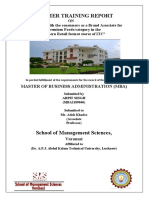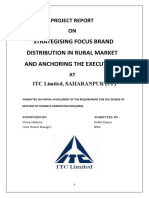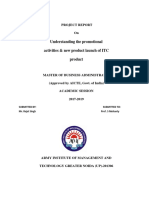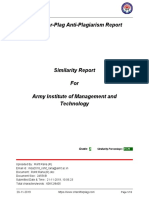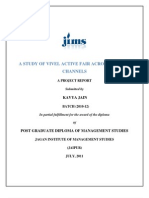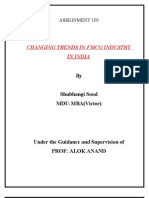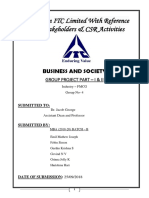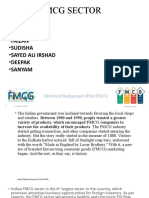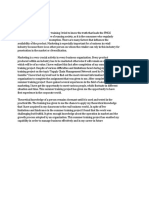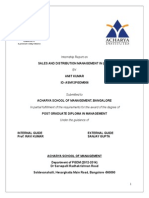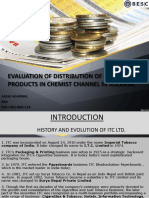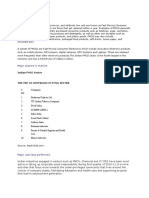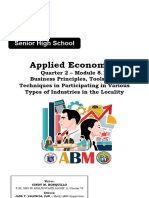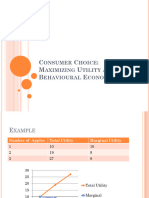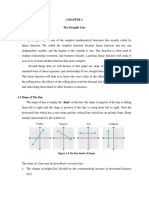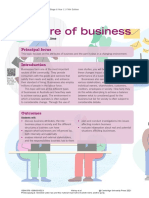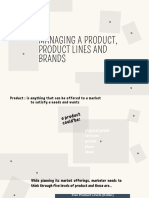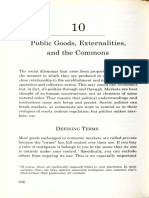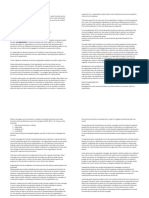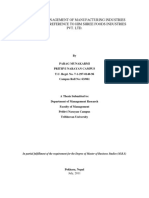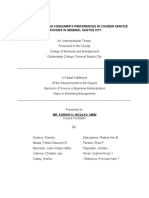Project Report on Marketing Internship at
ITC Limited
Prepared By:
Arwa Ratlamwala
AU1910138
B.B.A Hons.
Amrut Mody School of Management
August 2022
Project Report on Marketing Internship
At ITC
1
� Project Report on
Marketing Internship
At ITC Ltd.
August 2022
(Report submitted in partial fulfillment of the requirements of the
summer internship training undertaken for the BBA Hons. Program)
2
�Certificate of Completion
3
� Declaration
I declare that my Summer Internship Report entitled “Marketing Intern” submitted in partial
fulfillment of the Summer Internship Program is original and is not substantially the same as one
which has already been submitted in part or in full for any such similar qualification to the
University to the best of my knowledge.
Date: 31-07-22
Place: Ahmedabad Name of the student: Arwa Ratlamwala
4
� Acknowledgement
I put a lot of effort into finishing this report, and as a consequence, I understood its purpose.
Something is under there. I'm grateful to Mr. Jinkal Modi, our mentor, and, on a broader scale,
ITC Limited, for giving me the opportunity to learn about, assess, and experience ITC's
marketing channel and for driving me to pick up additional skills such as supervising salespeople
and interacting with various distributors. Without his supervision, the completion of this report
would not have been possible.
I am also appreciative of all the salesmen, specifically Ghanshyam, Aakash, Raju bhai, Nitin,
Vicky, Ravi, and Tarun, with whom I regularly went to look for unserviced outlets in order to
create a new route for new salesmen. I am grateful for the opportunity since it allowed me to
learn a lot and have fun.
5
� Table of Contents
Objectives, Scope and Limitations of the study.........................................................7
Industry & Company Orientation…...........................................................................8
1. Overview of ITC Industry.....................................................................................8
2. Prominent Players in Industry...............................................................................10
3. Brief Overview about Company.............................................................................11
4. Porters’ Five Force Analysis.................................................................................12
5. Organizational Frameworks…...............................................................................13
Training Activities…..................................................................................................16
Findings, Learning’s, and Suggestions…..................................................................18
1. Findings..........................................................................................................18
2. Learning.........................................................................................................19
3. Suggestions....................................................................................................19
Conclusions…...........................................................................................................21
Annexure...................................................................................................................22
1. Fortnight Reports….............................................................................................22
2. Further Contact Information…............................................................................34
Bibliography............................................................................................................35
6
� Objectives, Scope and Limitations of the study
Objectives:
The study's main goal was to examine the ITC Limited’s annual display outlets in order to
evaluate the profitability, marketability, and potential future growth of ITC's personal care
products. The information was gathered and examined in order to derive conclusions. This report
includes an introduction of the firm profile, a description of the methodology used, porters five
force analysis, and the conclusions drawn as well as a variety of graphs.
Scope:
This report will cover all relevant and important details regarding the internship program,
including how it was carried out, what each intern's tasks and responsibilities were, highlights
from the internship, lessons learned, and the company's approach to training and guiding
programs.
All the necessary information will be covered in this study, which will conclude with relevant
findings, lessons learned, and recommendations from the internship.
Limitations:
I had a lot of difficulties conducting this research. The hardest challenge I encountered while
doing this research was trying to collect data from store owners using a questionnaire. The
reason was because they were preoccupied with calls or receiving orders while on calls. If I
asked most of them while they were at work, they would not have any will. They were reluctant
and skeptical to answer. As a result, it was challenging to gather accurate data from them.
Since all the store owners are Guajarati’s and the most of them are unwilling to speak in Hindi, I
had to converse with them using my non fluent Gujarati, which was a major challenge. I am
quite fortunate that my distributors and supervisors can communicate in English. The research
was done in a limited time hence, detailed study could not be made.
7
� Industry and Company Orientation
Overview of FMCG Industry:
India's FMCG industry has significantly contributed to development of the nation. The large
range of commonly bought consumer goods, such as soaps, detergents, tooth pastes,
packaged foods detergents, shaving products etc., is an example of FMCG.
The FMCG products are those commodities that customers often eat on a regular basis. They
frequently have large volume and inexpensive price. This multi-billion dollar industry includes a
huge variety of well-known brand names that people use on a daily basis. Selling, marketing,
financing, buying are the key activities in the FMCG sector.
Operations, supply chain, production, and general management were also practices in the sector.
With better products, more businesses are entering this market. International consumer goods
companies are looking for inorganic development prospects in developing nations like India.
For their daily needs, a sizable portion of India's population depends on FMCG items.
Household Care, Personal Care, and Food & Beverages make up its main components. The top
FMCG companies are distinguished by their capacity to produce the goods that are most in
demand by consumers while simultaneously fostering brand loyalty and confidence.
The FMCG industry as a whole is probably going to have a very successful year in 2022-2023.
The FMCG sector is anticipated to reach a market size of over $220 billion by 2025, growing at
a rate of 14.7%. Due to factors like a rebound in urban demand and discretionary spending, as
well as price increases taken to offset the effects of rising raw material prices, the FMCG sector's
8
�revenue growth is anticipated to double in the upcoming fiscal year. We can anticipate that
demand will remain strong despite growing commodity costs, which will continue to put
pressure on performance, particularly in rural India, where income levels are rising and
consumers are more willing to spend. Low operational costs, distribution networks, the existence
of well-known FMCG brands and population expansion are some advantages of this industry.
Food Products ITC
Above given image shows the food products offered by ITC
Personal Care Products ITC
Above given image shows personal care products by ITC
9
�Prominent Players in the FMCG Industry:
Table 1.1 shows the list of all the prominent players in the FMCG Industry:
Prominent Companies in FMCG Industry
HUL Ltd.
ITC Ltd.
Nestle India
GCMMF Amul
Procter and Gamble
Dabur India
Cadbury India
Britania Industries
Asian Paints
Colgate- Palmolive Ltd.
Marico Industries
Johnson and Johnson
Godfrey Phillips
Amul India
Gillete
Modi Revlon
Godrej Ltd.
Nirma Ltd.
Henkel Spic
Wipro
10
�Brief about Company:
On August 24, 1910, an Indian company named ITC Limited was established. ITC Ltd formerly
known as Indian Tobacco Company is presently served by the company’s CEO Sanjiv Puri.
Kolkata serves as the company's registered office. It has more than 20,000 workers across more
than 60 locations in India.
Even in its newly launched areas of packaged foods & confectionery, branded apparel,
personal care, and stationery, it is quickly increasing market share. In terms of pretax profit, it
is the third-placed private sector company in India. ITC is a leading private sector organization
in India, with a market valuation of approximately US$22 billion and annual turnover of
US$10.74 billion.
ITC is recognized as one of Business World and Business Today's Most Respected and
Valuable Companies in India as well as one of Forbes magazine's Best Big Companies in the
World, Asia's "Fab 50," and the World's Most Reputable Companies. ITC is one of India's "10
Most Valuable (Company) Brands," according to a Brand Finance survey that was conducted
and covered by the Economic Times. ITC is one of the top 50 performing companies in Asia,
according to Business Week.
With a diverse business portfolio that includes hotels, foods, personal care, information
technology, lifestyle retailing, and agri businesses. Its products include cigarettes and tobacco,
paper and paperboards, packaging, and food and beverages. ITC is an example corporation for
its dedication to the triple bottom line and has ambitious growth plans for the future. ITC has
been one of the few businesses of its scale during the past few years to be both carbon and water
positive, and for the previous three years, solid waste recycling has been positive as well. It is
one of the few businesses that has made an effort to change its business strategies in order to
increase employment, build livelihoods, and add value to every individual.
11
�Porter’s Five Force Analysis:
Threat of new entrants: The risk of new entrants maybe low because higher capital investment
is required to enter a specific household consumption products market.
Bargaining Power of Suppliers: ITC merely encounters small amount of supplier power as
products from the suppliers are rarely having substitutes. The products are differentiated and
have very high switching cost. The suppliers who work regularly with these business have value
for their customers.
Bargaining Power of Buyers: There are many different types of buyer. The switching cost is
low and retailers have the purchasing power to bargain regarding the price of the commodity.
Threat of Substitutes: Although the power of the price of the commodity may be
compromised, the brand names continue to succeed in the commercial sector by creating a
competitive advantage.
Rivalry among competitors: It costs nothing for a consumer to choose one shampoo brand over
another, making the market very competitive. This sort of consumer appreciates having options.
ITC also uses price rivalry and introduces new products of a same or different segment eg: Bingo
recently introduced 2 new flavors in wafers which are pani puri and dahi chat flavours.
12
�Organizational Frameworks:
It is a framework that assists in the performance evaluation of managers and corporate
executives.
It has 7 elements, which would include:
Strategy
Skill
Structure
Shared Values
System
Staff
Style
Strategy:
ITC has developed distributed leadership inside the organization by supporting each business's
strong and committed top management teams. It has also developed a portfolio of world- class
companies that best fits organizational strength with possibilities in home and export markets,
creating various sources of growth. Its chosen portfolio remains its primary focus. They also
ensure that each of its businesses is excellent and competitive on a worldwide level. They also
accelerate the portfolio's ability skills found across IIC's various businesses.
Skills: Over the past five years alone, ITC has virtually quadrupled its personnel and doubled its
sales figures. The company's rising trend translates into more chances for advancement, pay,
responsibility, and general exposure to new clients and technologies. Every employee receives a
fairly sizable annual educational reimbursement allowance from us. ITC is committed to offering
13
�top-notch benefit and pay packages. They work hard to make sure that employment is their most
valuable resource.
Structure: ITC Ltd. has a flatter organizational structure supported by forward-thinking and
progressive companies.
https://www.itcportal.com/sustainability/sustainability-report-2008/governance-page-02.aspx
Shared Value: They are aware that ITC was handed to us in "confidence" by all of our
stakeholders because they are professional managers. They put the demands of the consumer
first and fulfill those expectations in terms of value, quality, and satisfaction. They uphold
people's humanity and dignity while also showing them respect and value.
14
�System: ITC Ltd. operates the various divisions of the corporation through well-defined
departments. The management makes sure that no such conflicts arise in the organization and
that these departments operate smoothly and effectively. Every day, the supervisors check on the
departments' work. Wherever necessary, employees are constantly provided with impromptu
talks and feedback. Regular evaluations are conducted by the supervisor.
Staff: ITC Company is very goal oriented and hold individual and collective teams to high
performance standards. They see people's humanity and dignity while also showing them respect
and value. They recognize that each member of the team contributes unique perspectives and
skills, and that a strong team is built on a diversity of viewpoints. They also urge people to have
aspirations, value diversity, create and try new things in search of chances and become leaders
through teamwork.
Style: ITC Ltd. believes in developing and inspiring young talent. They encourage participative
leadership, which gives each employee a voice in the governance or operational processes of the
company. Each employee's input is valued and considered while making decisions under
participatory leadership.
15
� Training Activities:
On the first day of internship I went to Shapath 5 where ITC office is located on the 8th floor and
the meeting initially began with a quick introduction of ITC Company, an overview of the
business, and its aims and procedures. I also met the supervisors, exceutives, distributors and
mentors and had an opportunity to speak with them.
The next day I was called at Rakhial office where I was introduces to the distributor by my
mentor. My mentor gave me a sheet of all the products and gave a description about variety of
products which ITC offered. My mentor was the one who helped me with my daily tasks and
told to directly report him if I faced any problems. I had to visit new outets in the route of
salesmen daily and then I had to report back to my distributor regarding the remarks of ITC
products which the shop owners had. I was also given an excel sheet weekly and my mentor
taught me how the details should be filled. The excel sheet included what items the shop owners
kept. This helped them in understanding which products ITC also had and the salespeople could
promote in their next visit. I was supposed to submit excel sheet daily to my mentor. I was also
told by my mentor to take pictures on gps camera app of the unserviced outlets where the shop
owner did not keep ITC product. A questionnaire was given to me which included details like wd
code, wd name, name of salesman, service day, reason why the outlet is unserviced, name of the
owner, his/her phone no. location, latitude, longitude of the shop and the products which they
keep in shop. I was told to make a new route for the new salespeople which could be done by
tracking all the unserviced outlets in one specific area.
I had to travel every week with different salespeople to different routes. I met various
shopkeepers daily and had to submit excel sheet daily to my mentor. I also had to make weekly
presentation of the unserviced outlets. I acquired some new skills like cooperation,
communication, listening, leadership, negotiation and exercising discipline. More importantly I
got to apply my practical knowledge which I acquired through academic in real life.
16
�Above given image shows the excel sheet which had to be submitted daily
Above given images were taken from gps cam app
17
� Findings, Learning’s, and Suggestions
Findings:
I had the opportunity to learn about ITC Ltd.'s retail coverage and marketing strategies
throughout this internship. Additionally, I realized how significant a role FMCG products
play, particularly during the period of COVID-19. Several findings include:
1. Compared to other age groups, customers in the 21–30 year range spend more money
on bath soap.
2. Customers find Aashirwad aata costly hence they mostly prefer to buy other aata.
3. Customers want lesser cost aata compared to high costing aata with good quality.
4. The majority of the time, people choose brands with better quality and well-
known names.
5. ITC provided packaged aggarbatis with offers as compared to homemade aggarbatis
yet customers bought homemade aggarbatis as it was for lesser price. Hence
customers pay less attention to packaging.
6. In contrast to other personal care goods, the respondents thought that the price or
the products were reasonable and acceptable.
7. Most customers purchase bath soap on a monthly basis, and usage of the product
is consistent.
8. The key factors influencing consumer decisions to purchase bath soap are the health
benefits, quality, and quantity. This indicates that the majority of consumers are
reluctant to switch from the brand they have been using.
9. When purchasing FMCG goods, considerations such as quality, price, and brand
name are crucial.
10. Most customers either choose or inquire about a certain brand of soap.
18
�Learnings:
The two-month internship at ITC added a lot of value to me. Though my thoughts were
challenging, solutions that had positive effects on the business were always commendable.
During these two months, life was a little challenging, and occasionally I felt unmotivated, but
persistence was the secret to my success.
I was able to better comprehend consumer expectations for current items because to the exposure
I gained through participating in direct sell-out operations. I was able to analyze and respond
appropriately by learning about the switching habits and customer preferences.
Additionally, I also had to supervise 5 salesmen and I also had to make a route of unserviced
outlet for the new salesmen and the work environment was completely different, but I was able
to deal with it and maintain a rapport with my distributors and supervisors.
Suggestions:
1. When I was interning I found that many salesman left their job as a result their shops
were then covered by a salesman with different work such as, the personal care
salesman was given the work of the salesman handling food department. Due to this the
salesman felt burden and half of their time went in searching shops. Hence they should
assign salesman in which the salesman could take order of both personal care as well as
food which would save time and effort.
2. I also found out that the Distributor of Ranip was not treating the salesman in proper way
and was not talking with respect. This may also be one of the reasons why so many
salesmen left their job.
3. It was seen that many customers bought aata of other companies as Aashirvaad aata as it
was very costly. The other reason could be that Aashirvaad atta is rarely advertised and
is considered to be ineffective. As Indian housewives are deemed to be the ones who
make the purchasing decisions for aata, the brand can therefore create an aggressive
advertisement to appeal to them.
19
�4. It may also sell its goods to organizations that serve meals to youngsters as part of the
midday meal program.
5. The corporation, which employs the umbrella branding marketing technique, can think of
the idea of creating a retail chain of food products that spans all of India. As more and
more products fall under umbrella categories like food processing, all food division
products in such retail chains can be sold at a reduced price.
20
� Conclusion:
It was a very fruitful internship for me as all the learnings which I had gained in academics
finally got practical application. This experience also helped me to comprehend the many
benefits and drawbacks of the PCP goods marketing sector. It also helped me to gain a thorough
understanding of the various company's products and the behaviors and abilities necessary to
become proficient. It changed inside of me with a great deal of confidence when I was
introduced into the market for the first time.
It inculcated a sense of duty and a desire in me to work hard for the company. I had the chance
to network with professionals who were well-positioned in the field. I was also told by my
mentor that I had filled the highest number of responses which is 80% and my superiors praised
me a lot
.
21
�Appendices
22
�23
�24
�25
�26
�27
�28
�29
�30
�Student Feedback Form
31
�32
�33
� Further Contact Details and Information:
Name of Student: Arwa Ratlamwala
Email: arwa.r@ahduni.edu.in
Contact Details: +91 9913629152
Name of Company Guide: Jinkal Modi
Email: Jinkal.Modi@itc.in
Contact Details: 8866484979
34
�Bibliography
(n.d.). Retrieved from ITC Portal: https://www.itcportal.com/
Achary, N. (2015). Top 20 Fast Moving Consumer Goods (FMCG) Companies in India. Retrieved from
Businessnewthisweek: http://businessnewsthisweek.com/business/top-20-fast-moving-
consumer-goods-fmcg-companies-in-india/
ITC Limited. (n.d.). Retrieved from Wikipedia: https://en.wikipedia.org/wiki/ITC_Limited
Kenton, W. (2021). Fast-Moving Consumer Goods (FMCG). Retrieved from Investopedia:
https://www.investopedia.com/terms/f/fastmoving-consumer-goods-fmcg.asp
35

